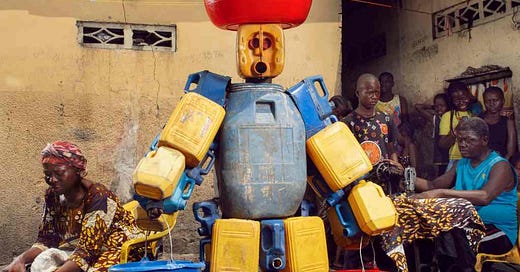10 More Things// Brand Loyalty, Ordinary Culture & Garbage Dump
In this edition: Brand loyalty is still misunderstood, the power of ordinary culture & creativity in the Congo
This week I’m think about… brand loyalty. I’m re-reading How Brands Grow at the moment about 7 years after I last read it. So much of the thinking is commonplace in marketing today - including brand loyalty.
We all know that brand loyalty doesn’t exist. At least that’s what I - and many others -have been saying since the book was published. However, that’s a misreading of the research. Brand loyalty does exist. Obviously! Duh! We can all think of a brand that we only ever buy. For me, it’s Muji pens. (Top tip: they are the best pens).
The reason Sharp attacks brand loyalty is because he says it’s correlated to market share. I.e. bigger brands have a lower defection rate than smaller brands, or in Ehrenberg-Bass language: they follow the double-jeopardy rule. The example given in the book is that, on average, car buyers defect at c.50%. That means 50% are brand loyal (in the analysed time period). This isn’t just true of your brand; this is true of every brand so the pool of potential car buyers is vastly bigger trying to recruit new people into your brand vs re-acquiring current customers.
Note: market share to defection rate is never a perfect correlation. Some brands will focus more energy on re-acquiring customers and their efforts will pay off with a lower defection rate. It’s a question of where you spend your time and resources. If you spend all - or even most - your time re-acquiring you will probably be beaten by competitors who are spending their time and resources recruiting new customers.
The other thing Sharp acknowledges is that brand fundamentalists exist. The insane people of this world who only buy their pens from one specific chain nowhere near where they live. However these people are statistically insignificant, they are swallowed up by the vastly greater amount of people that don’t just buy their pens in one place.
Brand loyalty exists, plain and simple. You can shape it, manipulate it (e.g. like Apple have done with their IOS ecosystem) and even purposefully increase it. It’s just not a helpful marketing strategy to grow market share.
Strategy and all that stuff
The Power of Ordinary Culture. A nice reminder that we confuse trends and culture but culture is where the real magic is.
“Everyday life is full of meaning, and the things we consider ‘normal’ are actually always worth thinking about and considering. If you think culture only comes from the fringes, is the domain of the elite, or is only found in the arts, then your comms will be missing out.”
The 4Cs. Not everything has to be about the 4 Cs. Sometimes it can just be the 2 Cs. How much emphasis you put on each is a strategic bet. Sometimes, as a matter of brand survival, it’s better to concentrate on doing 2 well.
The 3 Stages Of Strategy. Be a noticer, make stuff up & put it in a mislabelled box.
Creativity & campaigns
The Magical Garbage Dump Spirits of the Congo. Drawing attention to the trash crisis in Kinshasa where rich Western countries are sending their trash ruining the environment. “Why are they doing it? It gives them the feeling they are existing. The costumes draw attention and tell the story of this craziness”.
I Will Not Miss Season 36! (Reader note: I will miss season 36. However I am willing to watch season 3-6 again).
Middle-Aged Man Trading Cards Go Viral in Rural Japan Town. How Kawara, a small town in Fukuoka Prefecture, addressed the problem of young and old growing further apart by turning the old into collectable trading cards.
“The most popular of them all is probably All-Rounder Mr. Fujii (68), a former prison officer turned community volunteer. His card is so sought after that local kids have even started asking him for autographs”
Pick N Mix
Why Costco Went All In On Kirkland. Friends and long-term readers will know I’m obsessed by Costco. If you’re thinking ‘why should I care about some niche own brand from a retailer I’ve never been been to’? A reminder: Costco’s own-brand Kirkland is bigger than Nike.
Jensen Huang: The Rise And Rage of Nvidia’s Visionary Billionaire. What it takes to come from nothing to build one of the biggest ever companies. In 2013, when Nvidia was still just a graphics company making chips for arcade games, Huang first heard about neural networks and immediately pivoted to AI. Not just started an AI division, completely pivoted the company into becoming an AI company.
How Yard Sale Scaled. Clearly some great business minds running the show at Yard Sale. They use pubs as distribution hubs, which is a win-win for pubs who get a kickback from the food sold in their pubs and a perfect location to deliver around cities. The design of the menus, pizza boxes and individual store signs look amazing. And they aren’t on delivery apps so they can manage their own customer relationships. Plus it’s damn good pizza.
Peace out ✌️
Alex







